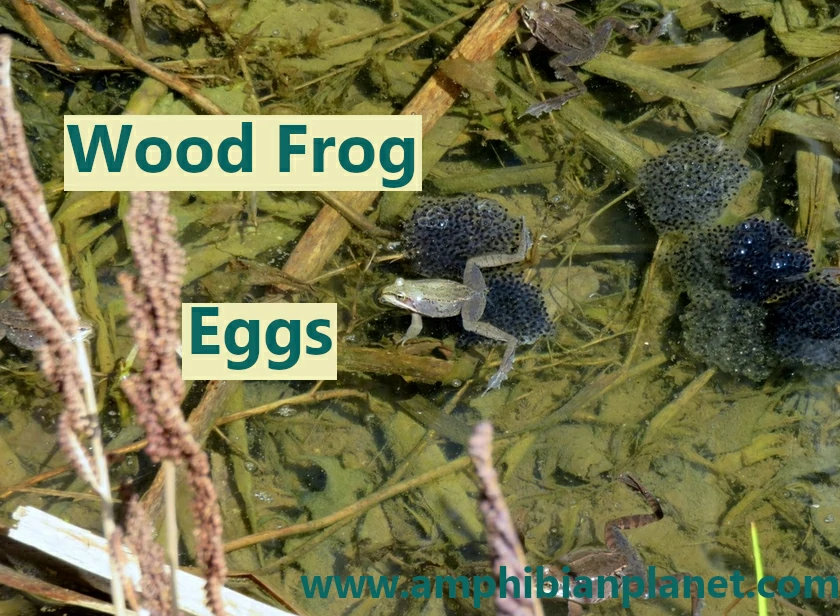Like most frogs, wood frogs (Lithobates sylvaticus) reproduce by laying eggs. These eggs are laid in the water and attached to twigs, grass, or other vegetation just slightly below the surface of the water.
Many wood frogs lay their eggs communally, so it’s common to find large stretches of wood frog eggs floating in the same pool.
Like other frog eggs, wood frog eggs do not have a hard outer shell to protect the developing embryos. Rather, each egg has a jelly coat.
This jelly coat absorbs UV-B some radiation, and also indirectly protects the eggs by virtue of its sticky texture and its tendency to accumulate a covering of pond debris.
Learning about wood frog eggs is great to add to your knowledge and feed your curiosity. Read on to find out everything you need to know about wood frog eggs including some really interesting facts, as well as how to easily identify them.
When Do Wood Frogs Lay Their Eggs?
Wood frogs lay their eggs in the springtime from March through May, depending on the latitude.
Wood frogs are often one of the first frogs to begin the breeding season; and may even begin breeding in early March, before the snow is completely gone, and when their breeding ponds are still partly frozen.
Wood frogs migrate to their breeding sites, on the first few rainy nights in early spring when the night temperature is above 40 degrees. This mass migration is often referred to as “the big night”.
In some towns, people close roads and gather to watch thousands of frogs and salamanders on their breeding migration.
During this migration, Wood frogs can travel significant distances, sometimes up to half a mile, to reach their breeding sites.
Wood frogs are explosive breeders, and breeding will typically occur over a one or two-week period.
Where Do Wood Frogs Lay Their Eggs?
Wood frogs lay their eggs in shallow, standing, freshwater bodies that are free of predatory fish. This could be in; seasonal pools, river backwaters, bogs, marshes, temporary rain puddles, and even in roadside ditches filled with rainwater.
However, Wood frogs very strongly prefer to breed in “vernal pools“, sometimes called “ephemeral pools.”

Vernal pools are temporal pools of water that form in the spring. They are formed when depressions on the ground are filled with water from melting snow and falling rain.
They are typically small and shallow, and unlike a pond or lake, they have no permanent source of water. This means they dry up in the summer.
Since they are temporal, they do not have fish or many other aquatic predators that could eat the eggs before they hatch.
This makes them ideal breeding sites for wood frogs and, many amphibians.
How Do Wood Frogs Lay Their Eggs?
Male wood frogs typically arrive at the breeding ponds before the females. Once they arrive, the males will begin to call for females (their call has been described as sounding like a flock of ducks quaking).
When the females arrive, the males will try to grab them from behind in a tight mating embrace called ‘amplexus’.
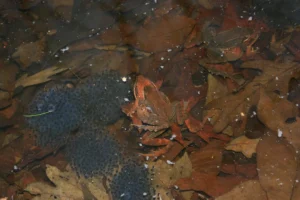
Once in the amplexus embrace, the pair will swim around as the female chooses a site to lay her eggs.
The female deposits a single egg mass on a twig just below the water surface, and the male releases sperm into the water, to fertilize the egg mass as the female lays it.
As earlier mentioned, wood frogs often lay their egg masses communally, so it’s common to find large rafts of wood frog egg masses, containing many layers of masses on top of one another.

Communally laid rafts are thought to create better conditions for development by raising the temperature of the embryos compared to the surrounding water. Warmer temperatures mean the eggs hatch quicker.
How Many Eggs Do Wood Frogs Lay?
In general, wood frogs can lay anywhere from 1,000 to as many as 3,000 eggs. Like in many other frog species, female body size is positively correlated with clutch size.
For this reason, large female Wood frogs will typically carry and lay more eggs than smaller females.
What Do Wood Frogs Look Like?
When first laid, wood frog egg masses are small and tightly compact, (about the size of a quarter), and are embedded in special secretions from a gland in the frog’s body.

Over a few hours, these secretions combine with water to create a jelly-like coating around each egg, and the egg mass swells up to approximately 5 inches (roughly the size of a softball).
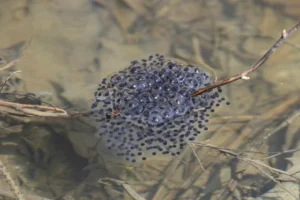
This jelly coat around each egg absorbs some UV-B radiation, and also indirectly protects the eggs by virtue of its sticky texture and its tendency to accumulate a covering of pond debris.
Once the egg masses absorb water and reach their maximum size, wood frog egg masses look like clumps of clear jelly-like globs, with a developing embryo visible inside each egg.
Looking down at an egg mass, the embryos will look black or dark brown and blend in with the surrounding darkness of the bottom of the pool. The undersides of the egg masses are a contrasting white or cream color.
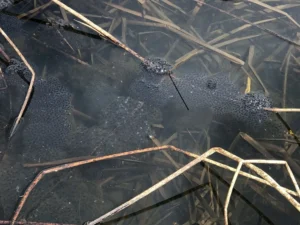
At a distance, wood frog egg masses appear bubble-like, where they break the surface of the water.

Over a short time, wood frog egg masses will deteriorate and flatten to the point where individual masses are no longer identifiable from the rest of the large floating raft. They may even become colonized by symbiotic algae, giving them a greenish coloration.
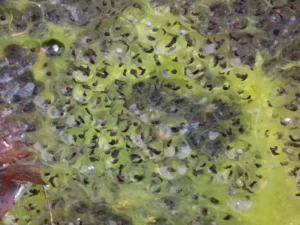
Green egg masses floating at the water’s surface might easily be mistaken for clumps of algae.

Do Wood Frogs Care For Their Eggs?
Wood frogs do not show parental care for their eggs. After the mating is complete, both the males and females will leave the pond, abandoning the eggs.
This means the eggs are all on their own and are at the mercy of the environmental conditions. They are also easy meals for lots of predators.
How Long Do Wood Frog Eggs Take To Hatch?
Wood frog eggs take about 9 to 30 days to hatch, depending on the environmental conditions. The eggs will typically develop and hatch faster in warmer temperatures and slower in colder temperatures.
Wood frog eggs laid in early when the weather is cooler will usually take longer to hatch than those laid in warmer weather.
What Do Wood Frog Tadpoles Look Like?
When they first hatch, wood frog tadpoles are very dark in color and about .25 inches long. As they grow, the dorsal color becomes brown and the venter develops gold flecking, giving them a more mottled appearance.
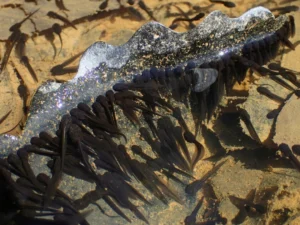
Newly hatched wood frog tadpoles remain with the egg mass for a few days, feeding on algae associated with the egg masses.

After a few days, the tadpoles leave their egg masses and begin feeding on phytoplankton and algae near the water’s surface.
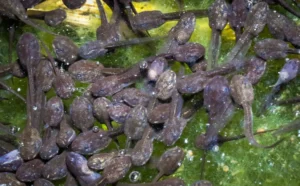
Wood frog tadpoles often school in shallow areas of the pool or float near the surface. Doing this allows them to absorb solar heat, in the relatively cool waters of a vernal pool.
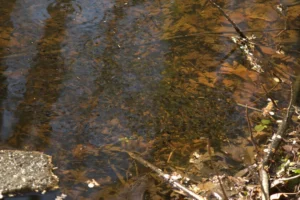
The tadpoles grow very rapidly and will undergo metamorphosis in about 2 months. This short larval period allows them to escape their temporal pools before the water dries up.

Do Wood Frogs Care For Their Tadpoles?
Some frog species such as the African bullfrog (Pyxicephalus adspersus) protect and attend to their tadpoles to improve their chances of survival.
However, wood frogs do not attend to their tadpoles or care for them in any way. Once mating and egg-laying is complete, both the males and females will leave the pond, only returning the next breeding season.
The Differences Between Wood Frog Eggs And Salamander Eggs
Wood frogs and salamanders (especially spotted salamanders) usually lay eggs in the same pools. Since these egg masses look very similar to each other, they can be difficult for the untrained eye to tell apart.
Here is how you can tell wood frog eggs from salamander eggs:
1. Appearance
The easiest way to tell wood frog eggs from salamander eggs is to look at the outer layer of the egg mass. Salamander egg masses are surrounded by a jelly coat, but wood frog egg masses are not.
If you took a close look at a wood frog egg mass, you would easily notice the contour of each individual egg on the outer layer of the egg mas. This contour gives wood frog egg masses a bumpy surface, sort of like a cluster of grapes.

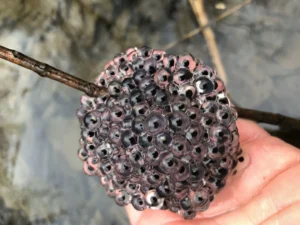
On the other hand, if you looked at a spotted salamander egg mass, you wouldn’t see the contour of the eggs on the outer layer, since the entire egg mass is covered in an outer layer of jelly.
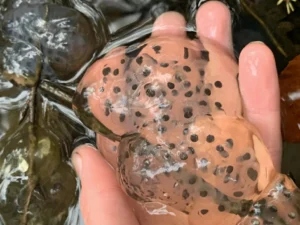
The surface of the egg mass would look smoother and more uniform. However, if you looked very closely into the jelly, you would see the outline of each egg within the mass.

When floating on the surface of the water, wood frog eggs will look bubbly and bumpy, while spotted salamander eggs will look like blobs of jelly with eggs visible inside.
Also, salamander egg masses sometimes have a cloudy white coloration, but this is never the case for wood frog eggs.
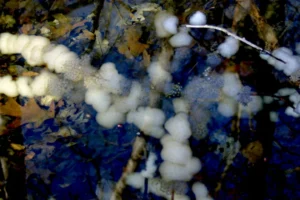
2. Texture
Another difference is that salamander eggs tend to be firmer and denser than wood frog eggs. If you were to gently poke salamander egg mass, it would meet your finger with resistance, while a wood frog egg mass would feel loose and give in to the slightest pressure.
Also, if you were to pick up a salamander egg mass, it would hold its shape even out of water. However, if you picked up a wood frog egg mass, it would be looser and the eggs would fall apart more easily.
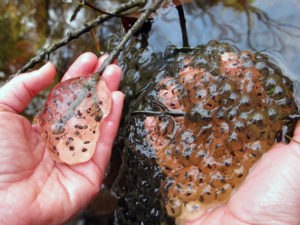
3. Location Within the Pool
Also, wood frogs and many salamanders (such as the spotted salamander) deposit their eggs communally, they do so in different ways.
Wood frogs often lay their eggs in large rafts. It is common to find large communal masses in a single area with eggs from multiple wood frogs.
On the other hand, salamanders such as the spotted salamander lay their eggs in individual clusters widely dispersed within a pool. Even when laid on the same stick, individual masses are very clearly identifiable.
What Animals Prey On Wood Frog Eggs?
Wood frog eggs are preyed on by many animals including newts, turtles, leeches, dragonfly larvae, diving beetles, and other large water bugs.

Once wood frog tadpoles hatch, they are preyed on by various aquatic insects (diving beetle adults & larvae, giant water bugs, etc.) as well as northern water snakes, ribbon snakes, turtles, and various wading birds.
What To Do If You Find Wood Frogs Eggs
If you live near a wooded area, especially near a pond, or another water body there’s a chance of encountering wood eggs in the spring. If this happens, be sure to avoid disturbing the eggs.
Disturbing or removing the eggs from the water could damage them, or even kill the tiny embryos developing inside the eggs.
If you find wood frog eggs out of the water, it is best to leave them alone, especially if they are very near the water.
However, if you find wood frog eggs that were disturbed (by a human or animal) and taken out of the water, you could try to put them back in the water.
If the egg mass is still attached to a stick, very gently put the stick back in the water (just a few inches below the surface).
Still, the eggs are not guaranteed to hatch because the disturbance may have damaged them or killed the embryos developing inside.
Of course, there’s no harm in observing wood frog eggs from a distance.
Featured image credit: mariepatricia (CC BY-NC 4.0)
Sources:
Brady, Steven. (2013). Microgeographic maladaptive performance and deme depression in response to roads and runoff. PeerJ. 1. e163. 10.7717/peerj.163.
Corn, P. S., & Livo, L. J. (1989). Leopard Frog and Wood Frog Reproduction in Colorado and Wyoming. Northwestern Naturalist, 70(1), 1–9. https://doi.org/10.2307/3536918
Virginia Herpetological Society: Wood Frog Lithobates sylvaticus
AmphibiaWeb. Rana sylvatica: Wood Frog. University of California, Berkeley, CA, USA.
Kiehl, K. 2015. “Lithobates sylvaticus“, Animal Diversity Web.
Canadian Herpetological Society: Wood Frog Lithobates sylvaticus

